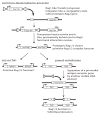The origins of the Rag genes--from transposition to V(D)J recombination
- PMID: 20004590
- PMCID: PMC2823946
- DOI: 10.1016/j.smim.2009.11.004
The origins of the Rag genes--from transposition to V(D)J recombination
Abstract
The recombination activating genes 1 and 2 (Rag1 and Rag2) encode the key enzyme that is required for the generation of the highly diversified antigen receptor repertoire central to adaptive immunity. The longstanding model proposed that this gene pair was acquired by horizontal gene transfer to explain its abrupt appearance in the vertebrate lineage. The analyses of the enormous amount of sequence data created by many genome sequencing projects now provide the basis for a more refined model as to how this unique gene pair evolved from a selfish DNA transposon into a sophisticated DNA recombinase essential for immunity.
(c) 2009 Elsevier Ltd. All rights reserved.
Figures


References
-
- Tonegawa S. Somatic generation of antibody diversity. Nature. 1983;302:575–81. - PubMed
-
- Sakano H, Huppi K, Heinrich G, Tonegawa S. Sequences at the somatic recombination sites of immunoglobulin light-chain genes. Nature. 1979;280:288–94. - PubMed
-
- Oettinger MA, Schatz DG, Gorka C, Baltimore D. RAG-1 and RAG-2, adjacent genes that synergistically activate V(D)J recombination. Science. 1990;248:1517–23. - PubMed
-
- Schatz DG, Oettinger MA, Baltimore D. The V(D)J recombination activating gene, RAG-1. Cell. 1989;59:1035–48. - PubMed
-
- van Gent DC, McBlane JF, Ramsden DA, Sadofsky MJ, Hesse JE, Gellert M. Initiation of V(D)J recombination in a cell-free system. Cell. 1995;81:925–34. - PubMed
Publication types
MeSH terms
Substances
Grants and funding
LinkOut - more resources
Full Text Sources

